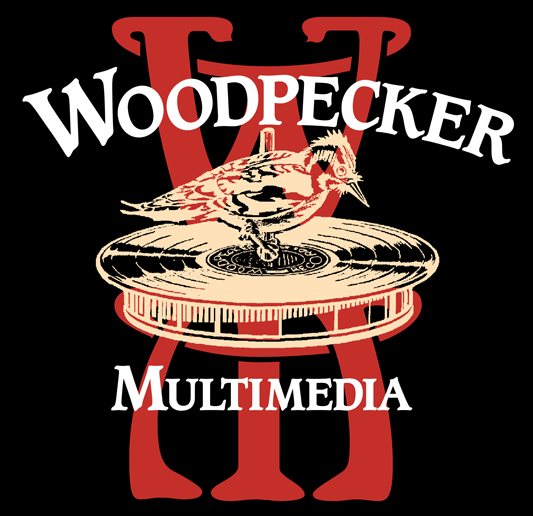 H
H
I Got Them Ol' Digital Music Archive Blues
Digging for old music in the digital pile is not as easy as it seems at first. The digitizing of music has gone through a roller coaster of roles as both villain and hero in the music scene of the new millennium, and lately many working musicians seem to be feeling even more ambivalent than usual about it. Music has become mostly free, so anyone who doesn’t want to spend money on it can enjoy an unprecedented amount of music without paying for it. This contributes greatly toward making it tougher than it has been in 90 years to make a living playing music. I used to sell a lot of CD’s, and now I hardly sell any, though it is sure easy to send invitations and messages out to your fans when you have a gig. I don’t miss putting stamps on postcards either. Social media and connections are a different tentacle of the digital octopus, and downloads, the thing that started it all, have largely morphed into the realm of digital streaming, where the action currently is. Listeners who are feasting on the free or cheap music have much more freedom to choose what they get to hear than radio listeners have ever had. We now have the option of paying to not have ads, though we don’t get the advantage of a knowledgeable human DJ. I can’t stand Pandora or Spotify robot-DJ algorithms, where you type in a song or an artist you like and they try to play you something similar that you will also like. You might hear a few good songs you never heard before, but if you pay attention, they always tend toward the popular and famous. If I start with an awesome but obscure artist, it seems within a few minutes I am hearing Jimmy Buffett and Van Morrison, since the software seems to assume that everyone is OK with popular and hackneyed songs, or else they are somehow getting paid or coerced to lead you there. Musicians also have a number of reasons to be happy with the digital music world, and we shouldn’t only complain about the bad aspects of the digital revolution, though it is killing our livelihoods. If you need to learn a song for fun or for a gig you no longer have to buy the album or the sheet music (if it exists), or pay a teacher to show you how it works. The lyrics, chords and sound files can almost always be found online, legally or illegally, though there are no standards of accuracy and it is a “caveat emptor” situation where you have no certainty of getting the right words or chords. I’ve been amazed at what a high percentage of lyrics posted online are wrong, and it seems that once one of them has posted something in error it gets copied endlessly. What I generally do now is grab the digital lyrics as a starting point, then carefully listen to a recording of the song, fix all the errors in the text, edit out the repeated choruses, odd punctuation and other dumb stuff, then print the song lyrics out and put them into a notebook, while keeping a text file in the computer. 10 years ago, when I searched the internet to find lyrics for Hank Williams' song "Jambalaya" the results were awful, and every version I found had huge errors with Cajun words like "bayou," "pirogue" and "filet," mixed with French town names like Thibodaux and Fontenot. Now I am heartened to find the top search hits showing correct lyrics.
Another aspect of the new digital reality than I’ve been knee-deep in for the past few months and enjoying immensely is that of having easy access to historical recordings. I am aware of the issue about whether I am missing a crucial element of those recordings by listening to digitized versions of it and not the original 78 records, but that is a tangential issue, and not worth re-hashing. This gigantic upside of the era of digital music doesn’t seem to get much press, though I have been happily immersed in studying and enjoying literally thousands of once-rare recordings of American blues, jazz, country, old-time, folk and even Hawaiian music from the first half of the 20th century. It has been mostly amazing, though intermittently exasperating. I don’t know what’s available for genres like Native American, Cajun or Klezmer music, but the old-time, country and blues things I’m primaily listening to are surprisingly well-represented, after what has felt like an interminable wait. It is unbelievable to be able to browse the digital music mountain in my pajamas, though it’s clear that it is a bit paradoxically “chicken and egglike.” It’s hard to imagine how anyone would want to be put in a huge room with tons of that old stuff if they didn’t already have an idea of what it was or have some background knowledge or connection to it. My kids (age 10 and 13 now) have access to all the music too, but they could care less about the 90-year-old songs from the Middle Ages that I am so hungry to hear. Here in the future (2018) with a 9-year-old computer and a modest internet connection it took me 19 seconds to go to my web browser to pull up and start listening to what in 1963 was the rarest of rare, the blues record collector’s Holy Grail. A copy of Paramount 12990, Son House’s “Dry Spell Blues,” recorded May 28, 1930 was first located that year by Gayle Dean Wardlow. I didn’t even have to type anything more than “Son House Dry” and the search engine suggested “Spell Blues” because so many others have searched for it also. (My son reminded me that speaking “Alexa, play Dry Spell Blues by Son House” to our robot was even faster, though I couldn’t be sure I was getting the 1930 version.)
It’s often the case that musicians from the past only have one good song, or just one sound or one rhythm groove, and all you want from them is a couple cool songs. Sometimes there is a unique song or a particular album from the past that is really different from the artists’s usual output, and this is where mining the digital mountain is really powerful. I’ve been aware of Sister Rosetta Tharpe for a long time, but in all of her music I had heard in the past when I tried to find out about her, she was always playing her heavy-handed guitar style on a rather awful-sounding electric guitar, on a bad-sounding live album, or with a gospel choir and band behind her. Just this week I discovered that she made some solo recordings with just an acoustic guitar, often a National metal-body, and it was a wonderful revelation to my troubadour ears. I especially like "Sit Down" and "My Man and I" and I am finally able to enjoy her unique solo guitar style, rhythm and singing. I also had never heard John Lee Hooker’s 1948 and 1949 solo recordings, of which only a few were originally released on 78’s. The whole session was not put onto a compilation LP (“The Legendary Modern Recordings”) until the 1970’s, and was put on CD in 1995, but I never heard them. A search on Amazon Unlimited turns up 208 albums by Hooker, and the one I wanted is not in their deceptive subset of “Popular Albums,” and can only be found by painstakingly scrolling through the “See All” category. I have heard Hooker all my life, but again my troubadour ears had never until I was 64 years old heard him just singing and playing an acoustic guitar by himself and stomping his foot. I don’t know whether to be happy or mad, though I am jealous when I read about how excited people like B.B. King, Albert Collins, Buddy Guy and Keith Richards got when they first heard some of that music long ago. It might have changed me if I had heard the original “Boogie Chillen’” 40 or 50 years sooner. Finding the Songs You Want Among the first observations I made was that you can’t find everything from any single source and it is a juggling act to search Apple, Amazon, YouTube and Spotify in search of certain songs. There are plenty of instances where only one of the platforms offers something I want, though at a glance they all seem awesome, and are stocked with millions of songs. Owners of recorded music have the option of making them available on the digital platforms, and thus are probably to blame for the absence of a particular recording rather than the platforms themselves, though when things appear on one platform and not another I don't know why. If a song or an album is not there, it is either due to the owners not bothering to do it, not knowing how, being philosophically opposed to the process, or being involved in conflicts or legal issues involving ownership. Some high profile artists like AC/DC long opposed and prevented the sale of their music in digital form, but eventually ended their resistance. I am being pretty fussy, but when I am after a particular song that Tammy Wynette recorded 50 years ago, for example, it’s different than what a casual listener might do who was just wondering what Tammy sounded like. Her 1969 recording of “Just A Closer Walk With Thee” is fabulous, and I have never heard a better version of the song. Yet it is still not to be found digitally on Apple, Spotify or Amazon Music, though it appears that at least 4 people have posted it illegally on YouTube where we can listen but not download or buy it. I’m glad I have the LP, but I feel bad for all the people who can’t hear it. Since it is a public domain song, maybe there is no financial incentive for anyone to make it available to us, or perhaps some dispute about it in her estate or within the record company or whoever owns the master recording. Since we are in a capitalist society, presumably money has to constantly be a factor in everything, even when our cultural heritage is at stake. I went looking for what I could find of the recordings of a fascinating duo of African-American string band musicians named Joe Evans and Arthur McClain, who recorded about 30 sides between 1927 and 1931. They show clearly that Bill Monroe did not invent bluegrass mandolin out of thin air, and that even though he admitted that Arnold Shultz taught him to play guitar, he never mentioned swiping mandolin ideas from black musicians. Amazon Unlimited offered only “Two White Horses in A Line,” while iTunes let me hear that one plus an awesome “John Henry,” “Old Hen Cackle,” and “Take A Look At That Baby.” A trip to YouTube yielded “Little Son of A Gun,” and an important fact that Document records had made an album of their work, but used their real names “Evans and McClain.” Back to Amazon I found the same 4 songs attributed to both “Evans and McClain” and to “Joe Evans & Arthur McClain” and “Arthur McClain & Joe Evans” on compilations by different labels, but not the Document CD I saw pictured on YouTube. Back to iTunes. A search for “Two Poor Boys” found 4 songs, but searching for “The Two Poor Boys” finally gave me what I wanted, so I could listen to or buy the whole album. When I searched for “The Two Poor Boys” back on Amazon, there were two Artist listings, one of which had a single song, and the other listed 5 songs. Apple won that round, offering me 20 tracks, including some alternate takes, though they misspelled “Down In Black Bottom” as “Balck Bottom.” Apple won that round hands down.
The tech giants have now made a high percentage of historical recordings available, but I’ve had to rely a great deal on individuals posting things on YouTube to give me access to numerous things I wanted to hear recently, including EmmyLou Harris’ lost first album from 1969, “Gliding Bird,” Mike Seeger’s “2nd Annual Farewell Reunion” album and Bentley Ball’s 1919 cowboy music recordings. It’s wonderful that I can listen to the music I want to hear, courtesy of a fellow music lover, without going to the Dark Web and not being part of the capitalist music-peddling schemes of the tech giants, even though I am quite grateful for what they have done, and I am sorry for artists who don't want people to hear old music they are embarrassed by. Searching One thing they are doing better at is putting the tag “(Live)” in the titles of live versions of songs, though it is not universally done, and is just an intermittently helpful practice that saves me time. Multiple Versions Redundant Names & Disambiguation If you are in one of the 100 million households who have already bought an Amazon Echo device, try asking it “Alexa, play some Jimmie Rodgers.” It’s a trick question, because there are three rather famous guitarist-singers with that name, even though they are mostly spelled differently, the voice-powered robot can’t tell the three names apart. Jimmie Rodgers (1897-1933), the first of the three, was the “Father of Country Music,” the “Singing Brakeman,” and the “Blue Yodeler,” who was wildly popular in the late 1920’s and early 1930’s. He seemed like a no-brainer for my vote for the most important of the three homonym-musicians. A Google search brings him up first, though 3 of the 8 photos next to his name and summary are actually Jimmie #2. I added the red arrows and numbers.
Jimmie #2 is a successful but forgettable pop country artist in the late 1950’s and early 60’s born James Frederick Rodgers (1933- ) who had a handful of hits, most noticeably “Honeycomb,” a million-selling gold record in 1957. Actually, I have never been able to get Alexa to play anything except Jimmie #2, which seems like a serious bug to me. (Apologies to Jimmie #2, who may be still alive and could be mad at me. I have my historian hat on, and in my estimation he is the least historically important of the three, and I’m certain he knows all about the other two Jimmies.) Jimmy #3, and my vote for the second most important of the three is Jimmy Rogers (1924-1997), a 1950’s Chicago bluesman who played in the Muddy Waters classic band, and had many hits of his own that were a big influence on the Rolling Stones and other fans of the Chicago blues style.
Here is a simple homework assignment: find the handful of solo blues songs like “Baby Blues,” and my favorite– “Blind’s Blues” by Alabama singer/guitarist John Lee. He has no Wikipedia page, and is sometimes called John A. Lee to distinguish him from blues icon John Lee Hooker, though there a different John A. Lee, as you might imagine, who has nothing to do with music, being a New Zealand politician. You may find the error I did, where one of several listings of John Lee’s song “Down at the Depot” was incorrectly attributed to John Lee Hooker. It's never been easy to be a minor artist with a similar name to a major one, but now it's really bad sometimes, though probably helpful in other ways to help you get heard. (I doubt anyone searching for a famous name musician would be glad to find other artists with the same name.) If you try to listen either of the two “Lonely Cowboy” Part 1 and Part 2 songs recorded in 1929 by Arthur Miles, the obscure but fascinating “throat-singing cowboy,” you have to fight through at least two other unrelated musicians also named Arthur Miles. The 1929 Arthur is not to be found on Amazon Unlimited or Spotify, though Spotify tries to address the issue by posting a thumbnail picture of each of the three other Arthur Miles. Unfortunately one is a picture of a lamppost, and the other two could be the same person but I can’t be sure, so there may only be one, two or three present-day Arthur Miles musicians on Spotify. One of the two 1929 songs is on iTunes in the album on the Viper label “Essential Pioneers of Country Music Vol 3. (1920’s-1940)," though if you click the link for his name, you get the newer Arthur Miles and no more of our cowboy. On YouTube there are half a dozen postings of both sides of the 1929 record, plus a strange bunch of covers and explanations offering to teach you to be a throat-singing cowboy also. A video is suggested, featuring yodeling accordionist Kerry Christensen getting together for a weird but possibly awesome yodeling/throat singing duet with Tuvan (Siberian) throat singer Ayan-ool Sam. YouTube wins again, but curated by “The People” and not a big tech company, and luckily this is not popular enough music so that I have to watch ads before I can hear America’s first (and maybe only) throat-singing & yodeling cowboy. Between 1928 and 1944 a very interesting and very good African-American guitar and mandolin player named Charlie McCoy (1909-1950) made close to a hundred important recordings that are tricky to find for several reasons. It’s a good but more difficult exercise in using your favorite internet music platform to try to find this early McCoy’s work. There are a huge number of modern businesses called "The McCoy Brothers" which spices up the searching for our blues McCoy friend. Charlie's tracks are variously catalogued as blues, early country, or string band music, some were played with his brother Joe as The McCoy Brothers or the Jackson Blue Boys. He also played duets as a sideman with Ishmon Bracey, Memphis Minnie and Tommy Johnson, and appeared in numerous bands like the Mississippi Hot Footers, Mississippi Blacksnakes, Harlem Hamfats and Mississippi Mudsteppers that didn’t feature his name anywhere, though he was always the featured soloist. His brother, under the name “Kansas City Joe” co-wrote, played and sang the lead vocal on the original recording of “When the Levee Breaks” that was famously covered by Led Zeppelin on their mega-platinum Zeppelin IV album in 1971. Adding much more confusion is the fact that a legendary (white) Nashville sideman also named Charlie McCoy became popular in the 1960s and played close to a dozen differnt instruments on an uncountable number of recording sessions (It’s not well-known that this McCoy played the stunning lead guitar part on Bob Dylan’s “Desolation Row”) though he is best-known for a number of big-selling solo recordings as a harmonica virtuoso. Here is country Charlie again, who is still alive as I write this.
Credits Dates Bad Data Blues As I was busily listening to Jimmie Rodgers records from the 1920s and 30s on Spotify, I saw that he had a version there of "I Am Bound For the Promised Land" which surprised me because I know and like that song. (It was on an album titled "A Rough Guide to Jimmie Rodgers." Luckily, I know Jimmie's voice and guitar style, and I knew right away it wasn't him, though it was listed with quite a few other gospel songs that turned out to be similarly misattributed. (It was Alfred Karnes.) When I Shazammed what Spotify said was Jimmie Rodgers singing "What A Friend We Have in Jesus," it came up as Eric Jackson singing "Always (The Wedding Song)" which mean that both Spotify and Shazam have at least one serious error in their data. I hate to break it to you, but there are what appear to be an uncountable number of such errors, and it's not clear how they got there or how they are going to get fixed, and robots aren't going to be as good at it as smart humans. I even suspect foul play or pranking, since on what is claimed to be an album called "Jimmie Sings Gospel For You" where an aging white singer with a piano and cheesy strings sings that song, Shazam says it is "Here, 2016" by Sho Maraka Feat. Lecrae." "The Old Rugged Cross" Shazzammed correctly, which indicates that there might be a real though lousy gospel singer also named Jimmie Rodgers that Spotify can't sort out, or who fraudulently got his music in there under that famous name as a prank or to get hits or money. Spotify shows "Chevrolet Car" by Sam McGee as being Jimmie also, as well as Darby and Tarlton's "Sweet Sarah Blues," which leads me to believe that an album of songs from the 1920s that featured a number of early country artists had all its tracks misattributed to Rodgers by whoever put it online. Early 1920s recording artist David Miller is difficult to research for three reasons: he shows up in lists as David, Davy and Davey, he shares his name with several contemporary musicians whose work he gets mixed up with, and he recorded under several pseudonyms. If he weren't such a good player it might not matter that he gets mixed up with other David Millers, but those of us searching for the roots of American fingerpicking guitar deserve to be able to easily listen to important his work without so much confusion. Before I go deeper, I explored a 2005 album on the Acrobat Music UK label titled "Ooze it Up To Me" by Darby & Tarleton, a white South Carolina duo from the 1920s, and their big hit "Birmingham Jail," that most boomers know as "Down in the Valley" from folk song books, was filled at least a dozen "skips" where the record was cracked or scratched, and nobody cared. I can't find misidentified tracks on that album, so this error is a new type, also hard to identify and fix. The first one is at :32 more at :57, 1:34, 1:55, 2:19, 2:28, 2:37, 2:42, 3:10 etc. Maybe they are some kind of digital glitches, but they sure sound analog at first listen. It's possible that owning a rare old 78 allows you to own that particular set of scratches and surface noise, and that you can't just steal another label's nice digital transfer even if the song copyright is expired. For scratchy old records, there are often a number of different transfers competing for your ears, but listed as the same song by the same artist. There are currently 15 different versions of Son House’s “Dry Spell Blues” on Amazon Unlimited Music. Seven of them are different listings of identical or very similar masterings or transfers from the 78rpm original 1930 recording, and another is a mislabeled version of Frank Jenkins’ 1927 solo fiddle/vocal version with the “Southern Broadcasters” string band of “Roving Cowboy.” Even the amazingly accurate song-identifying phone app Shazam agrees that the track is Son House. If you look up “Frank Jenkins” and try to play his song “Roving Cowboy” Amazon plays “Dry Spell Blues” which means there has been a switcheroo-mixup at Amazon Music that may take a long time to notice and fix. To make things worse, a search on Spotify for “Dry Spell Blues” shows a version by Charley Patton and one by Son House. Unfortunately, Charley Patton never recorded that song, and what appears to be his version is also Son House’s. Also unfortunately, House did Part I and Part II, which both show up as being on Patton’s album “Complete Recordings.” Patton did record a song called “Dry Well Blues.” If I play the song that Spotify says is Charley Patton "Dry Spell Blues Part 2," which I know is actually Son House, Shazam identifies it as Son House Part 1. Actually Spotify has completely screwed up, since it attributes what are also Son House’s versions of “Preachin’ Blues,” “My Black Mama” and “Walking Blues” to Charley Patton, though there are some genuine Patton songs on the album that claims to be his complete works. Confusing? Yes. I have found errors like this to be rampant, which means that if you are going to explore historical recordings on digital streaming platforms, beware of huge numbers of wrong attributions, misspellings and omissions, and good luck finding someone to complain to or who might try to correct errors you find. Robert Johnson Blues Any search for blues legend Robert Johnson’s music quickly becomes absurd– he left only 29 recorded songs, with 12 of them having two takes, which means we have exactly 41 different recordings, though an unknown number of transfers. (Since Steve Lavere, the guy who has controlled Johnson's copyrights since the 1970s is a lawyer, he probably rides herd on unauthorized postings, but that's a guess, and I just found out he died in 2015. What Johnson's son Claude, the new heir, chooses to do is anybody's guess.) A search for “All Songs” ballooned, and I lost count at a little over 600 different un-numbered entries, which also included nearly 50 spelling errors. You can find there [I did not misspell any of these myself] “Love in Vane” [not Vain] , “Deasd Shrimp Blues,” “Milckcow’s Blues,” “Me an d the Devil,” “Swett Home Chicago,” “Last Fare [Fair] Deal Going Down,” “When Yoiu Got A Goiod Friend,” along with “Preachin Blues,” “Preaching Blues,” “Preachin’ Blues,” “Preachin’ Blues (Up Jumped the Devil) [Remastered],” “Preachin’’ Blues (Up Jumped the Devil),” “Preachin’ Blues (Up Jumped The Devil) (Album Version),” “Crossroud Blues,” “Cross Road Blues,” “Cross Roads Blues,” “Crossroad Blues,” “Crossroads Blues,” and “Crossroad,” plus at least three other musicians with the same name. Worst of all, I found songs by Blind Willie Johnson and Meade Lux Lewis incorrectly attributed to Robert, and Willie McTell’s masterpiece “Statesboro Blues” wrongly attributed to Willie Johnson. Hey Lonnie Lonnie Lonnie Highly-skilled, versatile and influential guitarist and singer Lonnie Johnson’s first solo recording, “Falling Rain Blues,” was recorded in New York City on November 4, 1925, and released on Okeh Records, according to Jas Obrecht’s 2015 book “Early Blues.” This recording was made when Johnson was either 26 or 31 years old, depending on which source you believe for his birth year. The song is musically and historically interesting, partly because it was the first solo recording of an artist who had an unusually long and important recording career, and also because he was known as a guitarist, but sang and played violin at the same time on that cut, along with a piano accompaniment. A search for the string “falling rain lonnie” on Amazon Music Unlimited yields 16 un-numbered results, that are variously called “Falling Rain Blues,” “New Falling Rain Blues,” “Falling Rain Blues (live),” and “Falling Rain Blues (Remastered)” of which trial and error reveals that only two (#2 and #9 in the list) are played on violin, being different album releases of the 1925 original, currently available for sale on competing compilations of Johnson’s music. The remaining 15 songs in the list are multiple listings of at least two guitar/vocal re-recorded versions of Johnson singing and playing guitar that were done many years later. Searching Apple’s iTunes for the same string yields 17 numbered results, of which only #7 and #17 are the early version. Searching Spotify for “falling rain lonnie” yields the same set of errors. Nothing called “New Falling Rain Blues,” though 2 of the 4 results are the later guitar version that was improperly titled “Fallin’ Rain Blues” rather than “New Falling Rain Blues.” Another Spotify result is yet another re-recording on guitar, and the 1929 violin cut only appears once, though correctly titled, on the “Lonnie Johnson Vol. I” album on Document Records. None of the digitally-available Lonnie Johnson tracks I located contain any liner notes, songwriter/arranger or personnel information, nor the year or record label, though the second Apple result says it is from a Lonnie Johnson album called “Music All Around” that was put out in 2015 by Suncoast Music. The other result (#7 in the list) is flagged as being from a 2012 album by American Music Files titled “Lonnie Johnson Volume 1 (Remastered)". Neither of these years or record labels have anything whatsoever to do with the fact that Okeh Records recorded and released the song in 1925. Stefan Wirz’s massively researched and usually very helpful www.wirz.de web database does not yet list Lonnie Johnson as a bluesman yet, and says that his vast listings are “Under Construction.” The AllMusic listing for Johnson shows only things after 1958, which I have to guess just means LP’s or CD’s and does not address the first 33 years of original 78rpm singles. For clarity, I often turn to the University of California Santa Barbara’s Discography of American Historical Recordings (DAHR) which has a listing for Lonnie among its 262,000 entries. This resource is exhaustive but sometimes hard to operate, since it only sorts results one way, and insists on logging “Lonnie Johnson-vocalist” as a separate search from “Lonnie Johnson-guitarist” or even “Lonnie Johnson- fiddle.” It reveals that the November 1925 recording is Okeh catalog #9436, and that the pianist was named John Arnold. To use this resource to easily to compare the fiddle/vocal and guitar/vocal versions Lonnie did, I have to just use the “Vocalist” search. A handful of record labels that reissue old recordings (like Document) have adopted the helpful policy of sometimes including the year in parentheses as part of the title, and on other occasions the original label and catalog matrix number, like (Okeh 8829). None of the “Falling Rain Blues” results include either of these tags, though the one I am after could helpfully have been titled “Falling Rain Blues (1925).” I ran into similar snags when I was trying to learn about the first blues guitar instrumental, the “Guitar Rag,” recorded in 1923 by Sylvester Weaver. Those tags were very helpful, because Weaver recorded the same important song twice, before and after the technology switched over from the purely mechanical to the revolutionary Victor “electrical” system in 1926. Document Records helpfully labels one as “Guitar Rag- (Okeh 8109)" and the other as “Guitar Rag- (Okeh 8480)", but does not tell me anything else, including the year. I can get that from the DAHR, though first I have to choose from one of the following searches.
Name Date Range Occurrences Since I already know it is an instrumental done on the guitar I can proceed, but there would be no easy way to compare listings for two versions if he did the same song different times on banjo-guitar and guitar, which was the case with my research into Papa Charlie Jackson. I now can determine that November 2, 1923 Weaver made Okeh “S-Series” catalog # S-71997, and that on April 13, 1927, three and a half years later, the remake is shown as Okeh W-Series #W80727. Unfortunately, I can’t listen to them there, and I have to go back into the streaming listings, which in this case is easy because of Document’s song titling policy, though Document called them #8109 and #8480, which are not the same numbers as the DAHP listing. A trip back to Stefan Wirz shows “Guitar Blues,” the 1923 A side of the record as “Guitar Blues (71996-B)” and the other conflictingly as “Guitar Rag (71997-B),” a unique but different matrix number, and an indication that both songs were the B sides of something. Fortunately Wirz also included lovely scans of the actual 78 record labels, and there we can see clearly that “Guitar Blues” was 8109-A and the much more famous “Guitar Rag” was 8109-B, the B-side of the record.
We also find out from these pictures that the tunes were credited as being co-written by singer Sara Martin, which is mysterious, since she is not known to be an instrumental guitar player, though on Weaver’s first recordings (and for many years after that) he accompanied her singing. I have to guess that Okeh had two numbering systems in place, (the so-called “matrix numbers”) for studio recordings and another for records that were actually pressed and released, which is both sensible and confusing. The DAHP database has a symbol next to the songs that were pressed and released, but does not give their release numbers. These examples are very typical of what happens when you try to chase down a particular song, or even one of many versions of a song. John Lee Hooker has a signature song like “Boogie Chillen” where he recorded dozens of versions ranging over four decades, featuring an almost uncountable number of record labels, live versions, reissues and remasterings. It’s daunting to try to just enjoy the song or learn about it, though unfortunately, that song was quite important in my research into the American troubadour. iTunes shows 39 albums and 37 individual song listings for that song. Amazon Unlimited shows me 85 listings (un-numbered), of which I can only view 17 songs at a time on my big 27” computer screen, and far fewer on my laptop. (These of course won’t show me the numerous bootleg versions he did under pseudonyms like John Lee Booker, unless they were re-issued under his real name later, which did happen.) The 85 listings are variously titled Boogie Chillen, Boogie Chillen’, Boogie Chillen 2, Boogie Chillen No. 2, Boogie Chillen #2, Boogie Chillen No. 2 (Remastered), Boogie Chillen (Remastered), Boogie Chillen' [feat. Eric Clapton], Boogie Chillen John Lee Hooker [feat. Spain], Boogie Chillen [Clean], and helpfully Boogie Chillen (1949 Original Version) since that is the one I wanted. I didn’t have the strength to figure out how many of the 85 were also that same version.
Good luck in your digital music explorations! This is another posting where I'm trying to raise issues and awareness in the world of modern troubadours... You deserve a reward or a door prize for making it to the end. Please check back to look for new posts as I get them done. I plan to cover a wide range of issues and topics. Chordally yours, HARVEY REID ©2019
|

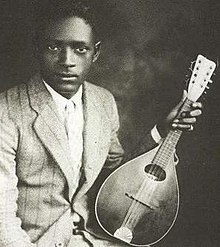
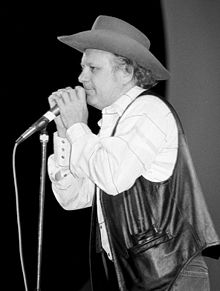 Two of the musical Charlie McCoy's
Two of the musical Charlie McCoy's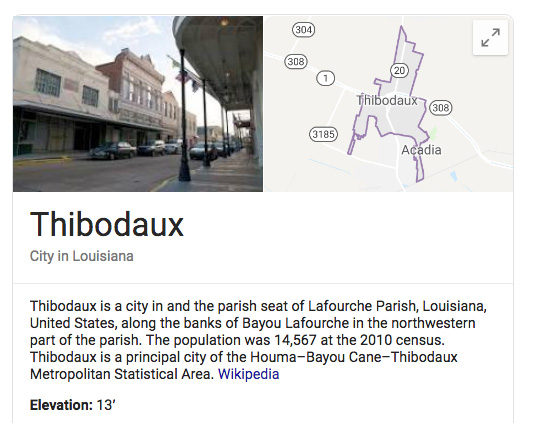
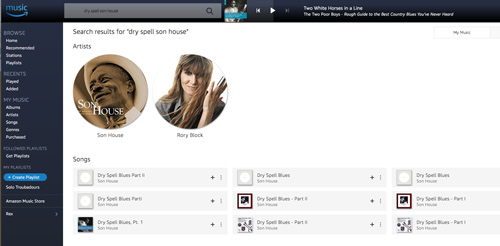
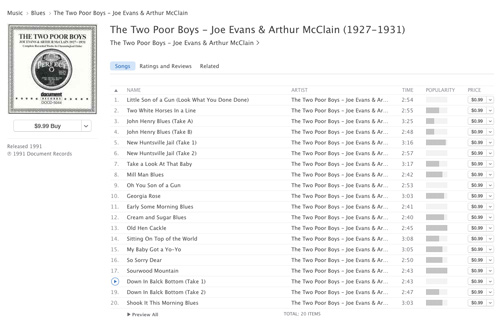
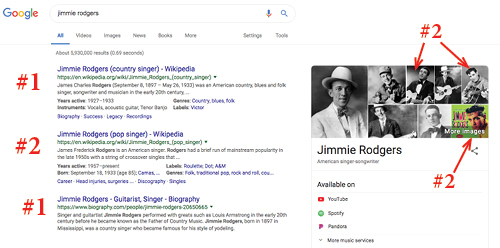

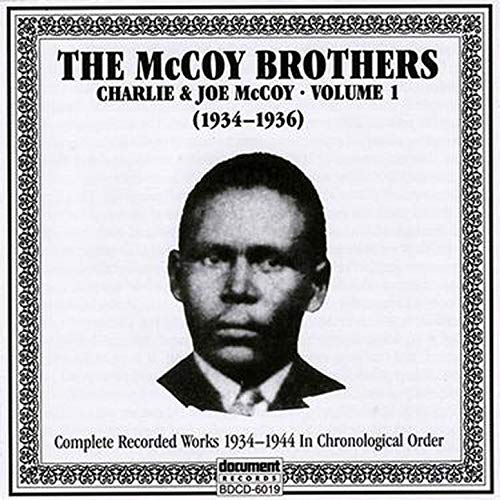
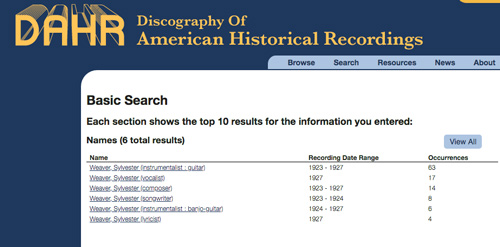
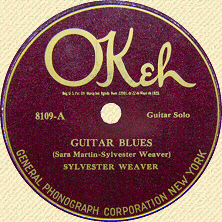
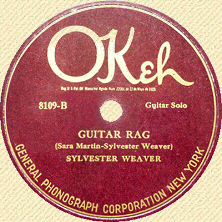
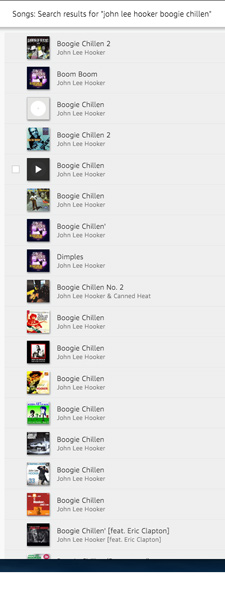 Unfortunately, these are only some of the numerous and maddening archiving errors and issues I have accidentally found in the streaming digital music archives, so best of luck in your own exploring, and don't bet any real money that anything you find there is correct. Maybe in another 20 years, if I am alive and can still hear and see I’ll be able to sift through the music archives more easily without it being riddled with glaring errors. But it sure is easier than buying all those records or borrowing them, or hoping someone would play them on the radio.
Unfortunately, these are only some of the numerous and maddening archiving errors and issues I have accidentally found in the streaming digital music archives, so best of luck in your own exploring, and don't bet any real money that anything you find there is correct. Maybe in another 20 years, if I am alive and can still hear and see I’ll be able to sift through the music archives more easily without it being riddled with glaring errors. But it sure is easier than buying all those records or borrowing them, or hoping someone would play them on the radio.